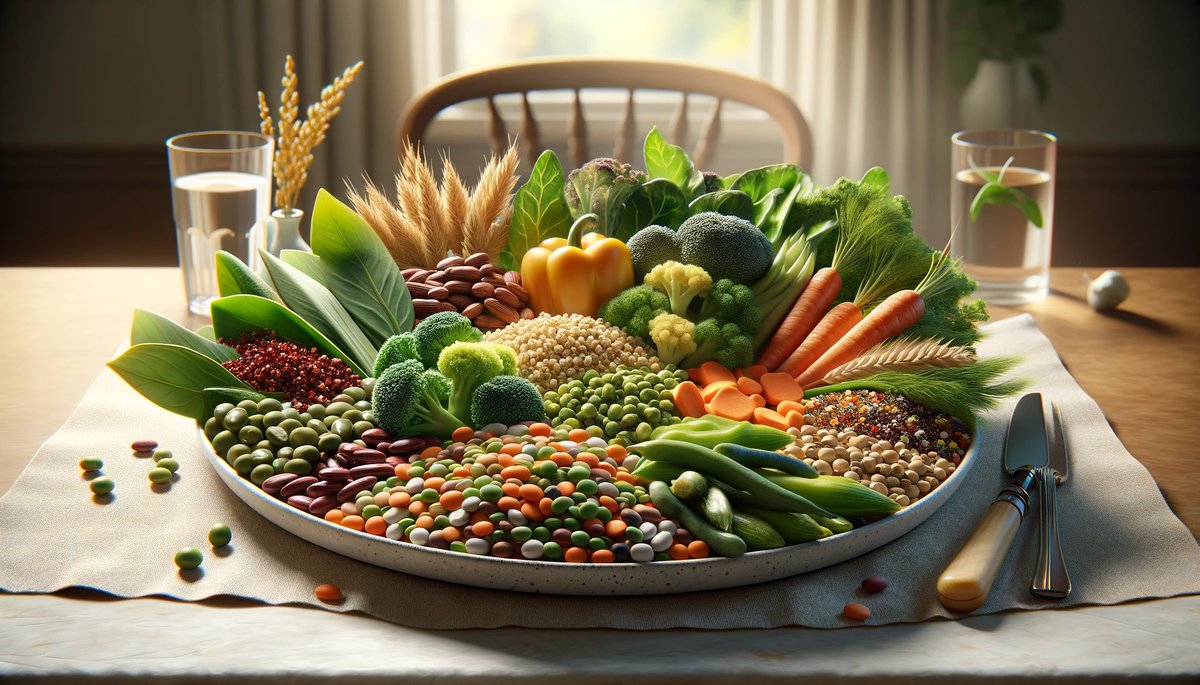Home>Special Themes>What Can I Eat During Lent?


Special Themes
What Can I Eat During Lent?
Published: February 27, 2024
Peter Smith, Editorial Director at Christian.net, combines deep insights into faith, politics, and culture to lead content creation that resonates widely. Awarded for his contributions to religious discourse, he previously headed a major organization for religious communicators, enhancing dialogue on faith's societal impacts.
Discover a variety of delicious and satisfying meal options for Lent, including seafood, vegetarian dishes, and special themed recipes. Find inspiration for your Lenten meals here!
(Many of the links in this article redirect to a specific reviewed product. Your purchase of these products through affiliate links helps to generate commission for Christian.net, at no extra cost. Learn more)
Table of Contents
Introduction
Lent is a significant period in the Christian calendar, observed by many denominations, including Catholics, Orthodox Christians, and some Protestant traditions. It is a time of reflection, repentance, and spiritual growth leading up to Easter. One of the key aspects of Lent is the practice of fasting and abstinence, which includes dietary restrictions. Many people wonder, "What can I eat during Lent?" This article will explore traditional Lenten foods, fasting and abstinence guidelines, as well as provide meal ideas for those observing Lent. Whether you're looking for meatless, dairy-free, seafood, or vegetarian options, there are plenty of delicious and satisfying choices to enjoy during this sacred season.
Read more: What To Eat During Lent Fasting?
Traditional Lenten Foods
During Lent, there are several traditional foods that hold special significance for those observing the season. These foods have been a part of Lenten traditions for centuries and are deeply rooted in the religious and cultural practices of many Christian communities. Some of the most common traditional Lenten foods include:
1. Fish
Fish is a staple during Lent, particularly on Fridays, when Catholics and some other Christians abstain from eating meat. This tradition stems from the historical association of fish with fasting and penance. Many people enjoy dishes such as baked or grilled fish, fish tacos, or seafood pasta as part of their Lenten meals.
2. Vegetables
Vegetables play a prominent role in Lenten cuisine, as they provide essential nutrients and are versatile in various recipes. Dishes like vegetable stir-fries, roasted vegetable medleys, and hearty vegetable soups are popular choices for those observing Lent.
3. Legumes
Legumes, including beans, lentils, and chickpeas, are a rich source of protein and are often featured in Lenten meals. They can be used to create satisfying and nourishing dishes such as bean stews, lentil curries, and chickpea salads.
Read more: What Can You Not Eat During Lent?
4. Grains
Grains such as rice, quinoa, and barley are commonly consumed during Lent. They serve as a foundation for many meatless meals and can be paired with vegetables, legumes, and flavorful seasonings to create delicious and filling dishes.
5. Fruits
Fruits are enjoyed as a refreshing and nutritious addition to Lenten meals. Whether eaten fresh, blended into smoothies, or incorporated into fruit salads, they provide a natural sweetness and a burst of vitamins and antioxidants.
These traditional Lenten foods not only offer sustenance but also symbolize the spiritual aspects of the season, emphasizing simplicity, humility, and mindfulness in eating. Incorporating these foods into one's diet during Lent can foster a deeper connection to the religious significance of the season while promoting health and well-being.
Fasting and Abstinence Guidelines
-
Fasting:
- Catholics between the ages of 18 and 59 are required to fast on Ash Wednesday and Good Friday. This entails consuming only one full meal and two smaller meals that, when combined, do not equal a full meal.
- Fasting is also encouraged on other days of Lent, but it is not obligatory for all. The purpose of fasting is to foster self-discipline, spiritual focus, and solidarity with the suffering of Christ.
-
Abstinence from Meat:
- Catholics aged 14 and older are obligated to abstain from eating meat on Ash Wednesday, Good Friday, and all Fridays during Lent. This includes not only red meat but also poultry and, in some cases, products derived from animals, such as gelatin.
- The practice of abstaining from meat is a symbolic way of honoring the sacrifice of Jesus Christ and expressing penitence.
-
Exceptions and Dispensations:
- Certain individuals, such as those with health conditions or strenuous physical labor requirements, may be exempt from the fasting and abstinence regulations.
- Bishops have the authority to grant dispensations or make adjustments to the fasting and abstinence guidelines based on specific circumstances within their dioceses.
-
Spiritual Significance:
- Fasting and abstinence are not merely about dietary restrictions; they are spiritual disciplines intended to deepen one's relationship with God and the community. By voluntarily embracing these practices, individuals seek to purify their hearts and draw closer to the divine.
-
Personal Reflection:
- Observing fasting and abstinence during Lent provides an opportunity for introspection, mindfulness, and solidarity with those who experience hunger and deprivation on a daily basis. It serves as a reminder of the importance of simplicity, gratitude, and compassion in our lives.
Understanding the fasting and abstinence guidelines for Lent is essential for those participating in this religious observance. By adhering to these practices, individuals can engage in a meaningful and transformative spiritual journey during the Lenten season.
Meatless Meal Ideas
-
Vegetable Stir-Fry: Create a vibrant and flavorful vegetable stir-fry using an assortment of colorful vegetables such as bell peppers, broccoli, snap peas, carrots, and mushrooms. Toss them in a savory sauce made with soy sauce, garlic, and ginger, and serve over a bed of steamed rice or quinoa for a satisfying meatless meal.
-
Eggplant Parmesan: Indulge in a classic Italian dish by preparing eggplant parmesan. Layer slices of breaded and baked eggplant with marinara sauce and melted mozzarella cheese for a hearty and comforting meatless entrée.
-
Spinach and Feta Stuffed Peppers: Roast bell peppers until tender, then fill them with a delicious mixture of sautéed spinach, feta cheese, and aromatic herbs. Baked to perfection, these stuffed peppers make for an elegant and nutritious meatless option.
-
Quinoa and Black Bean Tacos: Embrace the flavors of Mexico with quinoa and black bean tacos. Seasoned quinoa and black beans are nestled in warm tortillas and topped with fresh salsa, avocado, and a drizzle of lime crema for a delightful meatless taco night.
-
Mushroom Risotto: Prepare a creamy and luxurious mushroom risotto using Arborio rice, flavorful mushrooms, and a touch of white wine. This comforting dish is perfect for a cozy evening and showcases the rich flavors of the earthy mushrooms.
-
Lentil Shepherd's Pie: Craft a hearty and wholesome lentil shepherd's pie by layering seasoned lentils, mixed vegetables, and creamy mashed potatoes. Baked until golden and bubbling, this meatless twist on a classic comfort food is sure to be a hit.
-
Caprese Salad: Enjoy a light and refreshing meal with a classic Caprese salad. Slices of ripe tomatoes, fresh mozzarella, and fragrant basil are drizzled with balsamic glaze and olive oil, creating a simple yet elegant meatless dish.
-
Pasta Primavera: Whip up a vibrant pasta primavera featuring a medley of seasonal vegetables such as zucchini, cherry tomatoes, asparagus, and bell peppers. Toss the vegetables with al dente pasta and a light, herb-infused sauce for a delightful meatless pasta dish.
These meatless meal ideas offer a diverse array of flavors, textures, and cultural influences, providing ample inspiration for delicious and satisfying Lenten dining. Whether seeking a quick and easy option or a more elaborate culinary adventure, there are abundant possibilities for creating memorable meatless meals during the Lenten season.
Read more: What To Eat For Sunday Dinner During Lent
Dairy-Free Meal Ideas
-
Coconut Curry Lentil Soup: Prepare a comforting and aromatic coconut curry lentil soup by simmering red lentils, vegetables, and a blend of spices in creamy coconut milk. This dairy-free soup offers a perfect balance of warmth and nourishment.
-
Chickpea and Vegetable Tagine: Delight in the flavors of North African cuisine with a hearty chickpea and vegetable tagine. Slow-cooked with an array of spices, tomatoes, and tender vegetables, this dairy-free dish is a true celebration of robust and exotic flavors.
-
Crispy Tofu Stir-Fry: Enjoy a protein-packed and satisfying meal with a crispy tofu stir-fry. Toss crispy tofu cubes with an assortment of crisp vegetables and a savory stir-fry sauce for a delightful dairy-free option.
-
Mushroom and Spinach Risotto: Indulge in a creamy and luscious mushroom and spinach risotto made with dairy-free alternatives such as vegetable broth and nutritional yeast. This comforting dish showcases the earthy flavors of mushrooms and the vibrant essence of spinach.
-
Vegan Pad Thai: Experience the vibrant and tangy flavors of Thailand with a vegan pad Thai. Tossed with rice noodles, tofu, and an assortment of vegetables, this dairy-free rendition of a classic dish is a delightful fusion of sweet, sour, and savory elements.
-
Spaghetti Aglio e Olio: Savor the simplicity of a classic Italian dish with spaghetti aglio e olio. Toss al dente spaghetti with garlic-infused olive oil, red pepper flakes, and fresh parsley for a quick and flavorful dairy-free pasta option.
-
Black Bean and Sweet Potato Tacos: Embrace the robust and hearty flavors of black beans and sweet potatoes in a dairy-free taco filling. Nestle the flavorful mixture in warm tortillas and top with fresh salsa, avocado, and a squeeze of lime for a satisfying taco night.
-
Quinoa Stuffed Bell Peppers: Create a nutritious and colorful meal with quinoa stuffed bell peppers. Combine quinoa, vegetables, and aromatic herbs, then bake until the peppers are tender and the filling is fragrant, offering a delightful dairy-free entrée.
These dairy-free meal ideas showcase the diversity and abundance of options available for those observing a dairy-free diet during Lent. From global-inspired dishes to comforting classics, there are numerous ways to enjoy delicious and satisfying dairy-free meals while honoring the traditions of the Lenten season.
Seafood Meal Ideas
-
Grilled Salmon with Lemon-Dill Sauce: Fire up the grill and prepare succulent salmon fillets seasoned with a zesty blend of lemon, dill, and garlic. The smoky char from the grill enhances the natural richness of the salmon, creating a delectable and healthy seafood dish.
-
Shrimp Scampi Pasta: Indulge in a luxurious and flavorful shrimp scampi pasta dish. Sauté plump shrimp in a garlic-infused buttery sauce, then toss with al dente pasta and a sprinkle of fresh parsley for a delightful seafood pasta option.
-
Lemon-Garlic Butter Cod: Delight in the delicate and flaky texture of cod fish with a lemon-garlic butter sauce. Baked to perfection, this dish offers a harmonious blend of citrusy brightness and savory richness, making it a standout seafood entrée.
-
Cajun Blackened Catfish: Experience the bold and spicy flavors of Cajun cuisine with blackened catfish. Coated in a robust blend of Cajun spices, the catfish is seared to perfection, offering a tantalizing and fiery seafood option.
-
Lobster Bisque: Indulge in the luxurious and velvety texture of a classic lobster bisque. This rich and creamy soup, infused with the essence of lobster, provides a decadent and elegant seafood starter for a special Lenten meal.
-
Tuna Poke Bowl: Embrace the vibrant and fresh flavors of a tuna poke bowl. Marinated raw tuna, crisp vegetables, and creamy avocado are served over a bed of sushi rice, creating a colorful and nourishing seafood dish inspired by Hawaiian cuisine.
-
Miso Glazed Sea Bass: Savor the umami-rich flavors of miso glazed sea bass. The delicate sweetness of the miso glaze complements the buttery tenderness of the sea bass, resulting in a sophisticated and delectable seafood option.
-
Clam Linguine in White Wine Sauce: Enjoy a taste of the sea with a classic clam linguine in a white wine sauce. The briny essence of the clams, combined with the aromatic notes of white wine and garlic, creates a timeless and elegant seafood pasta dish.
These seafood meal ideas offer a diverse array of flavors, textures, and culinary influences, providing ample inspiration for creating memorable and satisfying seafood-centric meals during the Lenten season.
Vegetarian Meal Ideas
-
Eggplant Involtini: Indulge in a luxurious and flavorful vegetarian dish by preparing eggplant involtini. Thinly sliced eggplant is grilled and then rolled around a savory filling of ricotta, spinach, and herbs. Baked in a luscious marinara sauce and topped with melted mozzarella, this dish offers a delightful vegetarian twist on a classic Italian favorite.
-
Chickpea and Vegetable Curry: Embrace the vibrant and aromatic flavors of India with a hearty chickpea and vegetable curry. Simmered in a fragrant blend of spices, tomatoes, and coconut milk, this vegetarian curry offers a satisfying and nourishing option for a meatless meal.
-
Stuffed Portobello Mushrooms: Elevate your vegetarian dining experience with stuffed portobello mushrooms. The meaty texture of the mushrooms provides a perfect canvas for a delectable filling of quinoa, feta cheese, and sun-dried tomatoes, creating a robust and satisfying vegetarian entrée.
-
Butternut Squash Risotto: Delight in the creamy and comforting flavors of butternut squash risotto. The natural sweetness of the squash infuses the risotto with a luscious and velvety texture, offering a luxurious and satisfying vegetarian option for a special Lenten meal.
-
Vegetarian Paella: Experience the vibrant and savory essence of Spain with a vegetarian paella. Loaded with an assortment of vegetables, fragrant saffron-infused rice, and briny olives, this vegetarian rendition of a classic dish provides a delightful and colorful option for a meatless feast.
-
Caprese Stuffed Avocados: Enjoy a light and refreshing vegetarian dish with caprese stuffed avocados. Ripe avocados are filled with a medley of fresh tomatoes, mozzarella, basil, and a drizzle of balsamic glaze, creating a simple yet elegant option for a meatless meal.
-
Mushroom and Spinach Lasagna: Indulge in a rich and comforting vegetarian lasagna featuring layers of savory mushrooms, spinach, and creamy béchamel sauce. Baked to perfection, this hearty and satisfying dish is a delightful centerpiece for a Lenten gathering.
-
Vegetable Ratatouille: Delight in the rustic and aromatic flavors of a vegetable ratatouille. Slow-cooked with an array of seasonal vegetables such as eggplant, zucchini, and bell peppers, this vegetarian dish offers a colorful and wholesome option for a meatless meal.
These vegetarian meal ideas showcase the diversity and abundance of options available for those seeking delicious and satisfying meatless dining experiences during the Lenten season. Whether exploring global cuisines or savoring comforting classics, there are numerous ways to enjoy a rich and varied vegetarian culinary journey while honoring the traditions of Lent.
Conclusion
In conclusion, the Lenten season offers a time for spiritual reflection, repentance, and renewal, accompanied by the practice of fasting and abstinence. The dietary restrictions observed during Lent provide an opportunity to embrace a simpler and more mindful approach to eating, while also honoring the religious significance of the season. Traditional Lenten foods such as fish, vegetables, legumes, grains, and fruits serve as symbols of humility, simplicity, and spiritual nourishment.
As individuals navigate the dietary guidelines of Lent, they can explore a rich tapestry of meatless, dairy-free, seafood, and vegetarian meal ideas that not only adhere to the fasting and abstinence regulations but also celebrate the diversity and abundance of culinary traditions. From vibrant vegetable stir-fries to luxurious seafood bisques, there are countless ways to savor delicious and satisfying meals while observing the Lenten season.
Ultimately, the Lenten dietary practices serve as a reminder of the importance of self-discipline, gratitude, and compassion, both in the context of religious observance and in everyday life. By embracing the traditions of Lent with intention and creativity, individuals can cultivate a deeper connection to their faith, their communities, and the nourishing gifts of the earth.













